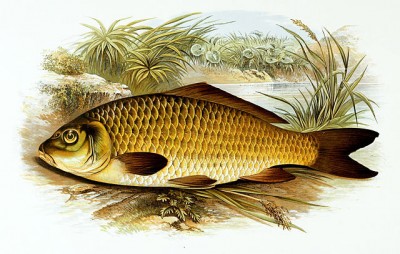Killing Carp in Australia: Genocidal Fantasies Down Under

“Trying to decide whether I side with the carp or Barnaby Joyce.” Jeff Sparrow, Twitter, May 1, 2016
Infections are the stuff of Australian agricultural policy, the daily business of a scientific establishment that has made killing and artificial guardianship of ecology central. Biosecurity is code for selective extermination and control, and it is a word that does more than just stalk the visitor to the world’s largest island continent.
The Deputy Prime Minister Barnaby Joyce has never shied away from his enthusiasm about controlling nature’s unruly creatures, by containment or death, even if unwittingly introduced by humans. He would have given it to Hollywood’s most famous pets, Pistol and Boo, cameras at the ready. Of course, he could never leave it at that, feeling the new-found pangs of directorship in criticising Johnny Depp and wife Amber Heard over their preposterous video of apology.
Apart from that farcical sideshow, the biosecurity business in Australia is serious. It is also conspicuously genocidal, and would satisfy any species-killing definition. Some sense of this could be gathered at the announcement earlier this month by the Science Minister Christopher Pyne that $15 million would be set aside for a plan to eradicate European Carp from the Murray Darling Basin using a strain of herpes, cyprinid herpesvirus-3. According to the Department of Agriculture and Water Resources, the fish make up 90 percent of the fish in the basin.
Language here is everything. The word eradication is repeatedly used regarding various introduced animal species in Australia, giving the impression that one is simply removing them from a specific environment. In fact, it would more appropriately be termed extermination. By 2045, Pyne has visions of a river system suitably and successfully cleansed – at least to the astrologically predicted degree of 95 percent.
Scientists such as Susan Lawler, ironically writing for a section of The Conversation named “This Thing Called Life”, wrote earlier in January about her enthusiasm (viral, perhaps?) for eliminating the species using a lethal, population-control virus. Without qualification, she suggested that, “Everyone wants to give Australian carp the herpes virus.”
With the usual ecological blindness that characterises such discussion, she argued that “research suggests that a viral control agent may be the most effective solution.”[1] Excited at the consensus, she saw before her eyes the coming together of an “unlikely coalition” spanning “fishers, conservationists, irrigators, scientists and farmers”.
The announcement by Pyne also sent the deputy prime minister into paroxysms on the floor of Parliament. “We are afflicted with these disgusting mud-sucking creatures, bottom dwelling mud-sucking creatures, for which the only version of control is a version of herpes to try to get rid of these disgusting mud-sucking creatures.”[2]
On Twitter, the member for New England announced with purpose that money had been committed “in an effort to rid our waterways of the [sic] one of the country’s most devastating pests.” His call to arms is an ominous reminder about how humans can be, not only to themselves, but to other species. “Carp are the rabbit of our waterways and we’ve now got a once-in-a-life-time opportunity to manage one of the country’s most devastating pests.”
With each seemingly dedicated program to eradicate a pest, the Australian scientific establishment has tended to create vast environmental problems. Programs of death are sold like targeted miracles, specific to a species, and supposedly minimal in environmental impact. In this case, warnings from carp fishermen that such a virus may well cause a pollution outbreak have not been heeded.
According to Garry Warrick, such animals, numbering in the thousands of tonnes would, if killed off in mass numbers, lead to another environmental catastrophe in its own right. In his measured words, such mass destruction would mean “there won’t be enough people to clean it up.”[3] Nor would the Environmental Protection Authority allow the burying of large quantities of deceased carp.
Houseboat operator Robert Hughes fears that the effect of such vast deceased animals would affect the tourist industry. “I think a river full of dead carp is not going to be fantastic for business.”[4] Then again, one should never underestimate the morbid fascination of a foreign guest. Visiting sites of mass death can sell.
The architect of death, Pyne, simply sees it in practical, utilitarian terms. Turn them into fertiliser, he argues, “or pet food maybe, or dig enormous holes and put them in there.” Independent Senator Nick Xenophon, barely able to stifle a giggle, also congratulated the minister “on his plan to give herpes to carp.”
Fertiliser companies are certainly looking forward to a jump in profits – murdering whole species, as humans have found amongst themselves, can be lucrative. “There are a huge amount of logistical and practical issues that have to be dealt with,” suggests Charlie Carp director Harold Clapham, but “we can use dead carp.”
Evidence, scrupulously avoided, suggests that such a plan will not work. There will, of course, be massive killing. Biodiversity will take a hammering. But Israel’s case suggests that the population may well rebound, making this a futile and vicious exercise in genocide. That, however, is the Australian way with animals, one sponsored by government, enacted by scientists, and cheered on by the populace.
Dr. Binoy Kampmark was a Commonwealth Scholar at Selwyn College, Cambridge. He lectures at RMIT University, Melbourne. Email: [email protected]
Notes

